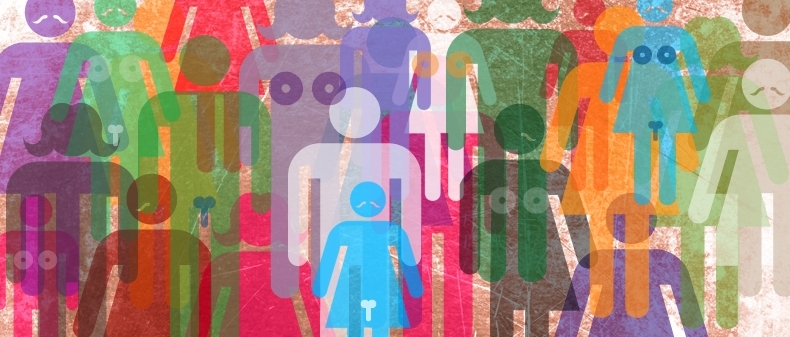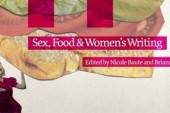
In the past few years, I’ve been introduced to terms relating to sex and sexuality that for some reason or another, escaped me during my most formative sexual years.
Maybe I was living in some linguistic and identification bubble, but I somehow managed to go through most of my teens and twenties, ignorant of more inclusive language, thinking I was a heterosexual woman (with ‘bi-curious tendencies’), and that people around me were either ‘straight,’ ‘gay’ or ‘bi.’
Fast-forward to my thirties and the introduction of language, expressions and identities that opened my eyes to how the world is truly made up, more than just the binaries of male or female, gay or straight. A bit difficult to traverse is the language used to describe aspects of sexuality. We see them more often now, but terms like ‘expression,’ ‘identity’ and ‘orientation’ are not interchangeable, and distinctions need to be made.
From The American Pychological Association Definition of Terms:
Sex refers to a person’s biological status and is typically categorized as male, female, or intersex (i.e., atypical combinations of features that usually distinguish male from female). There are a number of indicators of biological sex, including sex chromosomes, gonads, internal reproductive organs, and external genitalia.
Gender refers to the attitudes, feelings, and behaviors that a given culture associates with a person’s biological sex. Behavior that is compatible with cultural expectations is referred to as gender-normative; behaviors that are viewed as incompatible with these expectations constitute gender non-conformity.
Gender identity refers to “one’s sense of oneself as male, female, or transgender.” When one’s gender identity and biological sex are not congruent, the individual may identify as transsexual or as another transgender category.
Gender expression refers to the “…way in which a person acts to communicate gender within a given culture; for example, in terms of clothing, communication patterns and interests. A person’s gender expression may or may not be consistent with socially prescribed gender roles, and may or may not reflect his or her gender identity.”
Sexual orientation refers to the sex of those to whom one is sexually and romantically attracted. Categories of sexual orientation typically have included attraction to members of one’s own sex (gay men or lesbians), attraction to members of the other sex (heterosexuals), and attraction to members of both sexes (bisexuals). While these categories continue to be widely used, research has suggested that sexual orientation does not always appear in such definable categories and instead occurs on a continuum. In addition, some research indicates that sexual orientation is fluid for some people (emphasis mine).
It’s important to note the differences, because while the average person may not be aware, they do exist. Though I can easily identify myself as female (my sex organs are female, and I feel they belong to me and I to them), my proclivities are a lot more organic and complex, and I simply cannot pinpoint a specific sexual orientation for myself. To my mother, I would be a straight (sexual identity) female (gender identity), attracted to men (sexual orientation). To most who know me, all I could say without hesitation is that I’m female.
It’s only recently that I discovered the easiest label for me to be categorized by is ‘polysexual'(attracted to more than one sexual identity, with the understanding there are more than two). I’m attracted to and have had sex with both men and women, but I have not had experience with transgender, intersex or any other identity. Because I can’t say for certain yet if I’m attracted to them or not, I can’t say I’m pansexual (covering all identities). Whatever the case, as I get older, I realize that my attractions are to the person, not their package. And while people switch back and forth between types of careers, homes, books and clothes, why should sexes be different? More importantly, why should anybody care?
With a growing social appreciation toward diverse sexuality comes the need for more varied language, as the traditional umbrella terms ‘gay’ or ‘queer’ no longer cut it, morphing to LGBT to LGBTQ to LGBTTTIQ to cover more identities and orientations. I have the fortune (and choice) of being part of more distinct communities than the average person, and they teach me a lot. So I figure I’d share some of this knowledge to help your 2013 become more inclusive of those who are often rendered invisible.
Unless otherwise noted with * or †, the below is an excerpt from a compiled list by Angela M. Barbara, Gloria Chaim and Farzana Doctor for CAMH in Asking The Right Questions 2. I’ve also changed the list’s reference of outdated use of ‘transgendered’ to ‘transgender’ as the latter is the preferred adjective, like ‘female’ or ‘male.’
asexual: a word describing a person who is not sexually and/or romantically active, or not sexually and/or romantically attracted to other persons.
autosexual: a word describing a person whose significant sexual involvement is with oneself or a person who prefers masturbation to sex with a partner.
bisexual: a word describing a person whose sexual orientation is directed toward men and women, though not necessarily at the same time.
*cisgender: gender identity where an individual’s self-perception of their gender matches their sex. For example: I was born with female parts, and I identify as female.
family of choice: the circle of friends, partners, companions and perhaps ex-partners with which many LGBTTTIQ people surround themselves. This group gives the support, validation and sense of belonging that is often unavailable from the person’s family of origin.
family of origin: the biological family or the family that was significant in a person’s early development.
gay: a word to describe a person whose primary sexual orientation is to members of the same gender or who identifies as a member of the gay community. This word can refer to men and women, although many women prefer the term “lesbian.”
gender conforming: abiding by society’s gender rules, e.g., a woman dressing, acting, relating to others and thinking of herself as feminine or as a woman.
gender identity: a person’s own identification of being male, female or intersex; masculine, feminine, transgender or transsexual. Gender identity most often corresponds with one’s anatomical gender, but sometimes people’s gender identity doesn’t directly correspond to their anatomy.
genderqueer: this very recent term was coined by young people who experience a very fluid sense of both their gender identity and their sexual orientation, and who do not want to be constrained by absolute or static concepts. Instead, they prefer to be open to relocate themselves on the gender and sexual orientation continuums.
gender role: the public expression of gender identity. Gender role includes everything people do to show the world they are male, female, androgynous or ambivalent. It includes sexual signals, dress, hairstyle and manner of walking. In society, gender roles are usually considered to be masculine for men and feminine for women.
genderism: the belief that the binary construct of gender, in which there are only two genders (male and female), is the most normal, natural and preferred gender identity. This binary construct does not include or allow for people to be intersex, transgender, transsexual or genderqueer.
heterosexual privilege: the unrecognized and assumed privileges that people have if they are heterosexual. Examples of heterosexual privilege include: holding hands or kissing in public without fearing threat, not questioning the normalcy of your sexual orientation, raising children without fears of state intervention or worries that your children will experience discrimination because of your heterosexuality.
homosexual†: Outdated clinical term considered derogatory and offensive by many gay and lesbian people.
intersex: a person who has some mixture of male and female genetic and/or physical sex characteristics. Formerly called “hermaphrodites.” Many intersex people consider themselves to be part of the trans community.
lesbian: a female whose primary sexual orientation is to other women or who identifies as a member of the lesbian community.
LGBTTTIQ: a common acronym for lesbian, gay, bisexual, transsexual, transgender, two-spirit, intersex and queer individuals/communities. This acronym may or may not be used in a particular community. For example, in some places, the acronym LGBT (for lesbian, gay, bisexual and transgender/transsexual) may be more common.
MSM: refers to any man who has sex with a man, whether he identifies as gay, bisexual or heterosexual. This term highlights the distinction between sexual behaviour and sexual identity (i.e., sexual orientation). A person’s sexual behaviour may manifest itself into a sexual identity, but the reverse is not always true; sexual orientation is not always reflective of sexual behaviour.
passing: describes transgender or transsexual people’s ability to be accepted as their preferred gender. The term refers primarily to acceptance by people the individual does not know, or who do not know that the individual is transgender or transsexual. Typically, passing involves a mix of physical gender cues (e.g., clothing, hairstyle, voice), behaviour, manner and conduct when interacting with others. Passing can also refer to hiding one’s sexual orientation, as in “passing for straight.”
pansexual*: an orientation that encompasses the attraction to all sexual identities
polysexual: an orientation that does not limit affection, romance or sexual attraction to any one gender or sex, and that further recognizes there are more than just two sexes.
queer: traditionally, a derogatory and offensive term for LGBTTTIQ people. Many LGBTTTIQ people have reclaimed this word and use it proudly to describe their identity. Some transsexual and transgender people identify as queers; others do not.
questioning: people who are questioning their gender identity or sexual orientation and who often choose to explore options.
sexual behaviour: what people do sexually. Not necessarily congruent with sexual orientation and/or sexual identity.
sexual identity: one’s identification to self (and others) of one’s sexual orientation. Not necessarily congruent with sexual orientation and/or sexual behaviour.
sexual minorities: include people who identify as LGBTTTIQ.
transgender: a person whose gender identity is different from his or her biological sex, regardless of the status of surgical and hormonal gender reassignment processes. Often used as an umbrella term to include transsexuals, transgenderists, transvestites (crossdressers), and two-spirit, intersex and transgender people.
transition: the process (which for some people may also be referred to as the “gender reassignment process”) whereby transsexual people change their appearance and bodies to match their internal (gender) identity, while living their lives full-time in their preferred gender role.
transsensual: a term for a person who is primarily attracted to transgender or transsexual people.
transsexual†: An older term which originated in the medical and psychological communities. While some transsexual people still prefer to use the term to describe themselves, many transgender people prefer the term transgender to transsexual. Unlike transgender, transsexual is not an umbrella term, as many transgender people do not identify as transsexual. It is best to ask which term an individual prefers.
two-spirit*: an umbrella term sometimes used for Indigenous North Americans who fulfill one of many mixed gender roles found traditionally among many Native Americans and Canadian First Nations communities.
Though we still have a long way to go toward acknowledgement and acceptance of anything past the gender binary, it’s comfort to know that however anyone identifies, there’s at least a small community somewhere that will welcome without judgment {which isn’t to say these communities don’t judge against others. Judgment and prejudice is not limited to straight}. It’s also nice to be relieved of my juvenile ideas that I have to fit into some kind of unchanging box. As with anything in my life, I get bored or listless after too long and need change. There’s something grand to be said that variety is the spice of life, and it shouldn’t be limited to outside the bedroom.
* Wikipedia
†GLADD Media Reference Guide
For further information, you can refer to sites like CAMH or GLAAD.
____
Got a question about sex in art, relationships, parenting? Send Sonya a note at dearmadame@torontostandard.com. Anonymity assured.
Sonya JF Barnett, also known as “The Madame,” is the founder of an erotic arts community called The Keyhole Sessions and the co-founder of SlutWalk Toronto. Follow her on Twitter @KeyholeSessions.
For more, follow us on Twitter @TorontoStandard and subscribe to our newsletter.














